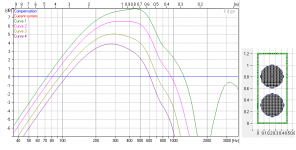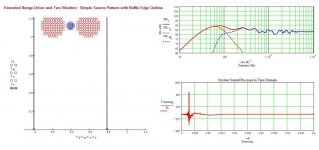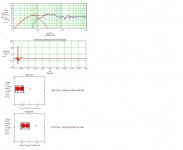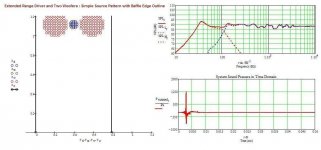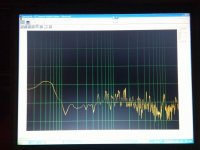Inspired by the PAP Trio15 Horn1, I plan on making a DIY speaker that will utilise 2 woofers per speaker on open baffles. Those woofers will need to play up to about 600 Hz. The PAP Neo woofers are obviously possible candidates, or there is the AE dipole woofers. Any other top quality OB woofers I should be considering?
Inspired by the PAP Trio15 Horn1, I plan on making a DIY speaker that will utilise 2 woofers per speaker on open baffles. Those woofers will need to play up to about 600 Hz. The PAP Neo woofers are obviously possible candidates, or there is the AE dipole woofers. Any other top quality OB woofers I should be considering?
I think that given your requirements, those two options are probably going to be the most suitable that you will find. There aren't that many alternatives, really. It's a pretty stringent set of design criteria.
Marco
PHY woofers are designed for open baffle and go quite high. They are expensive though.
http://www.phy-hp.com/
http://www.phy-hp.com/
Couple of questions:
1. Frequency extension required?
2. Assuming the bottom woofer is rolled off earlier than 600hz. Is c-t-c
spacing ok for 600hz crossover?
3. How high SPL required?
I've used some low QTS drivers from B&C 15TBX100 with shorting rings and they sound really good up the 600hz range but rolls off a lot around 45Hz in OB so would require massive EQ. Lots of punch.
Troels used the 15PR400 from Faital. Going that high up in frequency I prefer the lower QTS drivers. If under 200hz any of the higher QTS drivers have more extension. Only a personal preferences suggestions here.
1. Frequency extension required?
2. Assuming the bottom woofer is rolled off earlier than 600hz. Is c-t-c
spacing ok for 600hz crossover?
3. How high SPL required?
I've used some low QTS drivers from B&C 15TBX100 with shorting rings and they sound really good up the 600hz range but rolls off a lot around 45Hz in OB so would require massive EQ. Lots of punch.
Troels used the 15PR400 from Faital. Going that high up in frequency I prefer the lower QTS drivers. If under 200hz any of the higher QTS drivers have more extension. Only a personal preferences suggestions here.
I have used the Mach 1 drivers on open baffle to 500hz crossing to an Edgar midrange horn using a first order crossover.
They work well and have a nice sounding midrange.More of a medium Qts speaker.
https://www.google.com/url?sa=t&rct...-w-1500.html&usg=AOvVaw06Ney6NPHPInGrgKYEurtt
They work well and have a nice sounding midrange.More of a medium Qts speaker.
https://www.google.com/url?sa=t&rct...-w-1500.html&usg=AOvVaw06Ney6NPHPInGrgKYEurtt
I hate to be a heretic and suggest NON-high-end drivers here, but the Goldwood 18" GW-1858 is worth taking a look at and is inexpensive:
https://www.parts-express.com/goldwood-gw-1858-18-pro-woofer--290-386
Below is a pic of a large OB system using these drivers by John Busch. Despite the low Xmax in the MFG spec these drivers can generate some pretty good bass to 40Hz and below due to the large baffle and cone areas. JB claimed the response could extend down to the mid 20Hz range if the baffle has some short wings added (see pic). I have heard this system in person and it sounded good.
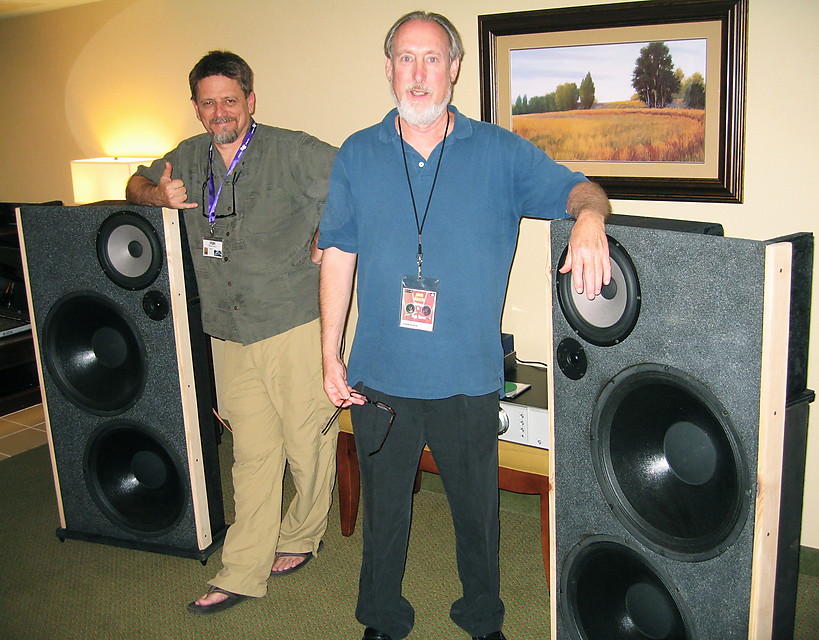
https://www.parts-express.com/goldwood-gw-1858-18-pro-woofer--290-386
Below is a pic of a large OB system using these drivers by John Busch. Despite the low Xmax in the MFG spec these drivers can generate some pretty good bass to 40Hz and below due to the large baffle and cone areas. JB claimed the response could extend down to the mid 20Hz range if the baffle has some short wings added (see pic). I have heard this system in person and it sounded good.

I went through the answers just to be sure.
There is no OB bass driver that could be extended to 600 Hz.
OB, H-frame and U-frame have LF roll off, but they exhibit also a low midrange hump due to front and back radiation synphase overlay, and then they experience yet another phenomenon - the baffle step.
Bass crossover in any OB type of enclosure is dictated solely by it's physical dimensions and is aimed at a frequency where the LP crossover slope would equal the slope of the said hump for a half octave and then the output rolls off. So a 130 Hz electrical crossover gives actual -6 dB at 250 Hz.
1. Read this site from front to back and vice versa:
http://www.quarter-wave.com
2. Present us with a simulation of an ideal bass driver on any open enclosure that returns satisfactory frequency response from 20 to 600 Hz.
Then we'll think again.
P.S. "2." is impossible, so use "1." and the second paragraph of the present.
Good luck!
There is no OB bass driver that could be extended to 600 Hz.
OB, H-frame and U-frame have LF roll off, but they exhibit also a low midrange hump due to front and back radiation synphase overlay, and then they experience yet another phenomenon - the baffle step.
Bass crossover in any OB type of enclosure is dictated solely by it's physical dimensions and is aimed at a frequency where the LP crossover slope would equal the slope of the said hump for a half octave and then the output rolls off. So a 130 Hz electrical crossover gives actual -6 dB at 250 Hz.
1. Read this site from front to back and vice versa:
http://www.quarter-wave.com
2. Present us with a simulation of an ideal bass driver on any open enclosure that returns satisfactory frequency response from 20 to 600 Hz.
Then we'll think again.
P.S. "2." is impossible, so use "1." and the second paragraph of the present.
Good luck!
OK, it is no problem to show that this concept CAN AND WILL WORK despite your skepticism. I present a simulation of an OB measuring 0.5mx1.2m (planar, no wings) using two of the Goldwood GW-1858 18" woofers I mentioned in my earlier post. The sim models angle 0-15-30-45 degrees in the horizontal plane starting at a point on the baffle just above the upper driver and below the top of the baffle. THis is where you would likely put a mid or fullranger driver.
As you can see, there is the null that T101 alludes to but the response rolls off into the dip just around the 600Hz target that you were hoping to meet. So I think this combination of two 18" drivers, whatever they may be, can work up to that point as long as the 18er can support it. Subwoofer type 18" drivers will probably not work to 600Hz but the 1858 can.
This sim is of the effect of the baffle and driver diameter only. It assumes drivers with infinite bandwidth (e.g. does not take into account the driver's own repsponse). At the low end, the sim shows the classic 6dB-per-octave response of a dipole system. On top of that you have to add the curve of the driver on the OB, which to a first order approximation will be like the free-air response, or a closed box response with infinite box size (infinite baffle response). This is where the Goldwood driver is good: it has a Qts around 1 and Fs of around 40Hz, so its own response is not falling off until 35HZ or so. Avoid drivers with Qts<0.4 because their own response will be drooping below 100Hz and this is just more loss that you need to make up (by applying more power, etc) and the power requirement can really get out of hand.
The low frequency that can be reproduced by these drivers is a factor of how much power you can apply, the Xmax limitation, and how loud you would like them to play. Like I mentioned, I heard these exact drivers in John Bush's "Widow Maker" system and the bass sounded very good.
As you can see, there is the null that T101 alludes to but the response rolls off into the dip just around the 600Hz target that you were hoping to meet. So I think this combination of two 18" drivers, whatever they may be, can work up to that point as long as the 18er can support it. Subwoofer type 18" drivers will probably not work to 600Hz but the 1858 can.
This sim is of the effect of the baffle and driver diameter only. It assumes drivers with infinite bandwidth (e.g. does not take into account the driver's own repsponse). At the low end, the sim shows the classic 6dB-per-octave response of a dipole system. On top of that you have to add the curve of the driver on the OB, which to a first order approximation will be like the free-air response, or a closed box response with infinite box size (infinite baffle response). This is where the Goldwood driver is good: it has a Qts around 1 and Fs of around 40Hz, so its own response is not falling off until 35HZ or so. Avoid drivers with Qts<0.4 because their own response will be drooping below 100Hz and this is just more loss that you need to make up (by applying more power, etc) and the power requirement can really get out of hand.
The low frequency that can be reproduced by these drivers is a factor of how much power you can apply, the Xmax limitation, and how loud you would like them to play. Like I mentioned, I heard these exact drivers in John Bush's "Widow Maker" system and the bass sounded very good.
Attachments
I'd rather stick to what I designed - 30 Hz@ ~0 or -3. Some old preliminary designs shown... without the sub bass channel... Nevermind the high mid-tweeter dip, this is just baffle/concept measurement.
You are showing exactly what I am talking about, 30@-15 and 20@-18 at most. I reality it could be as bad as 30@-30. So you prove my statement. The bass cannot be reproduced in a 0-600 Hz channel.
Ihave H-frames with the Goldwood and it is crossed over at 130 Hz as per MJK Mathcad simulations.
You are showing exactly what I am talking about, 30@-15 and 20@-18 at most. I reality it could be as bad as 30@-30. So you prove my statement. The bass cannot be reproduced in a 0-600 Hz channel.
Ihave H-frames with the Goldwood and it is crossed over at 130 Hz as per MJK Mathcad simulations.
Attachments
Last edited:
So... you don't believe in crossover networks or something? Of course, any dipole system must be equalized and a crossover used. This is the same whether it is an H-frame or a planar baffle. So I don't really think that you have a leg to stand on there.
Also, your response predictions are way too passimistic WRT the response vs passband level at certain frequencies, e.g. your "30@-15" or whatever. The way I read the plot, 30dB is about 6-8dB below the reference level. Remember, the dipole peak, which is at about 500Hz in this system, is at +6dB WRT the nominal (e.g. sealed box) SPL. That's because at the dipole peak, the front and back waves are interfering constructively. It's really not as bad as it may seem (to you).
You can create both EQ and crossover for the 1858 by adding a very large inductor in series with the drivers (put the drivers in series, too, to make that inductor more affordable!). The series inductor will tip the curve down at 6dB/octave. Although you will lose sensitivity, the result is that the curve is flattened AND you will generate a natural LP crossover at around 600Hz. Active filters or DSP can do the same thing.
So, I do not see how you can say that this setup cannot reproduce "the bass" (your words). This is despite the exact system being built and heard by many people who say the bass sounds great. Hmmm, one of these two things cannot be correct, my friend...
I believe that the reason you have to cross over your H-frame much lower (you claim 130Hz) is because of the 1/4 line resonance, NOT the dipole peak. That is totally legit for your system, but you have a totally different response issue to deal with.
Also, your response predictions are way too passimistic WRT the response vs passband level at certain frequencies, e.g. your "30@-15" or whatever. The way I read the plot, 30dB is about 6-8dB below the reference level. Remember, the dipole peak, which is at about 500Hz in this system, is at +6dB WRT the nominal (e.g. sealed box) SPL. That's because at the dipole peak, the front and back waves are interfering constructively. It's really not as bad as it may seem (to you).
You can create both EQ and crossover for the 1858 by adding a very large inductor in series with the drivers (put the drivers in series, too, to make that inductor more affordable!). The series inductor will tip the curve down at 6dB/octave. Although you will lose sensitivity, the result is that the curve is flattened AND you will generate a natural LP crossover at around 600Hz. Active filters or DSP can do the same thing.
So, I do not see how you can say that this setup cannot reproduce "the bass" (your words). This is despite the exact system being built and heard by many people who say the bass sounds great. Hmmm, one of these two things cannot be correct, my friend...
I believe that the reason you have to cross over your H-frame much lower (you claim 130Hz) is because of the 1/4 line resonance, NOT the dipole peak. That is totally legit for your system, but you have a totally different response issue to deal with.
Last edited:
So... you don't believe in crossover networks or something? Of course, any dipole system must be equalized and a crossover used. This is the same whether it is an H-frame or a planar baffle. So I don't really think that you have a leg to stand on there.
Also, your response predictions are way too passimistic WRT the response vs passband level at certain frequencies, e.g. your "30@-15" or whatever. The way I read the plot, 30dB is about 6-8dB below the reference level. Remember, the dipole peak, which is at about 500Hz in this system, is at +6dB WRT the nominal (e.g. sealed box) SPL. That's because at the dipole peak, the front and back waves are interfering constructively. It's really not as bad as it may seem (to you).
You can create both EQ and crossover for the 1858 by adding a very large inductor in series with the drivers (put the drivers in series, too, to make that inductor more affordable!). The series inductor will tip the curve down at 6dB/octave. Although you will lose sensitivity, the result is that the curve is flattened AND you will generate a natural LP crossover at around 600Hz. Active filters or DSP can do the same thing.
So, I do not see how you can say that this setup cannot reproduce "the bass" (your words). This is despite the exact system being built and heard by many people who say the bass sounds great. Hmmm, one of these two things cannot be correct, my friend...
I believe that the reason you have to cross over your H-frame much lower (you claim 130Hz) is because of the 1/4 line resonance, NOT the dipole peak. That is totally legit for your system, but you have a totally different response issue to deal with.
You need to bring up your your knowledge.
The GW1858 is great when used and crossed over in the technically correct manner. Which you do not seem to have the grounds for.
I dont see open baffles in your link.
Ever since MJK ceased his participation here the energy of the knowledgeable users to explain the OB theory and know-how is declining.
Now there are topics ot tens of answers about OB without anyone mentioning the basic design principles.
Yes my dear, you could EQ a tweeter down to 20 Hz, so what?
With this kind of participation you beat up the knowledge and technology.
You know nothing of OB, but you still "sell" your cure.
There are basic design principles that should be at least remotely studied. Do it. Read my first post in that thread. And stop filling the Internet with @#$&.
Ever since MJK ceased his participation here the energy of the knowledgeable users to explain the OB theory and know-how is declining.
Now there are topics ot tens of answers about OB without anyone mentioning the basic design principles.
Yes my dear, you could EQ a tweeter down to 20 Hz, so what?
With this kind of participation you beat up the knowledge and technology.
You know nothing of OB, but you still "sell" your cure.
There are basic design principles that should be at least remotely studied. Do it. Read my first post in that thread. And stop filling the Internet with @#$&.
And stop filling the Internet with @#$&.
OK, yeah I got it, thanks T101! You are a pleasure to talk to. Bye now.
There are basic design principles that should be at least remotely studied. Do it. Read my first post in that thread. And stop filling the Internet with @#$&.
Goodness me.
Charlie has been a great contributor to this forum, and you'd do well to recognise that.
If you can find something factually wrong with any of the posts here, feel free to point out where people are going wrong, and correct them. I've got no problem with constructive discussion.
Right now you're sticking your head in the sand, saying <600Hz can't be covered by one driver on an OB, without actually backing up anything you're saying with hard evidence.
It can be done, though. I've done 60Hz-1kHz with a single 10" driver (Faital Pro 10FH520). Going lower is possible, but requires greater cone excursion.
A 12" or 15" will probably manage it just fine.
Chris
- Status
- This old topic is closed. If you want to reopen this topic, contact a moderator using the "Report Post" button.
- Home
- Loudspeakers
- Multi-Way
- Best OB woofer up to 600 Hz?
